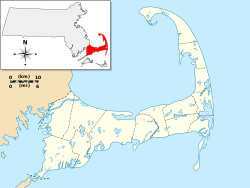History of the Dune Shacks
The Wampanoag people inhabited and used all of the lands within the national seashore, including the dunes area, prior to European settlement in the 1600s. [4]
The Massachusetts Humane Society built some of the earliest extant structures in the dunes area in 1872 to house members of the United States Life-Saving Service, whose mission was to assist survivors of shipwrecks. [5] [6] The dune shacks are mentioned by Henry David Thoreau in his book "Cape Cod" published in 1865. [5]
During the 1920s, the current shacks were beginning to be built, reputedly using the flotsam of washed up shipwrecks. These shacks were appealing to the many artists and writers who had begun to be attracted to the artist's colony in Provincetown; they would live in the spartan solitude of the shacks writing or painting. "Probably the most famous of these was playwright Eugene O'Neill, who purchased one and spent many summers there with his second wife, Agnes Boulton. O'Neill penned Anna Christie (1920) and The Hairy Ape (1921) while living in his shack, and in doing so gave the whole collection of dune shacks something of an arty cachet." [5]
Other artists and writers lived in the primitive dune shacks, including Harry Kemp who proclaimed himself "the Poet of the Dunes," [7] Jack Kerouac, E. E. Cummings, Norman Mailer, and Jackson Pollock. [5] In 2016, musician and artist Jacob Bannon stayed in one of the dune shacks for seven days painting and recording music, culminating in the release of a book and album both under the name Dunedevil . [8] The shacks have never had electricity, plumbing, or running water. [5]
Writers who wrote about the dune shacks, besides Thoreau, included Henry Beston, whose The Outermost House chronicles a season spent living in the dune shacks, and Hazel Hawthorne-Werner, who wrote Salt House about her year in the dunes in 1929. *** The Outermost House is in Eastham, near the Lifeguard Station, Cape Cod National Seashore. ('He looked out onto the o p e n Atlantic Ocean.')
Today, there are 19 dune shacks in the historic district, 18 of which are owned by the National Park Service. The dune shacks are accessible through private tours or hiking trails maintained by the National Seashore.
This page is based on this
Wikipedia article Text is available under the
CC BY-SA 4.0 license; additional terms may apply.
Images, videos and audio are available under their respective licenses.

